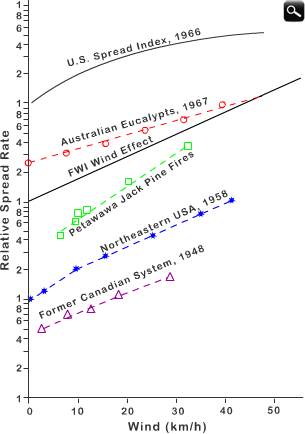Weather
In chapter two we have already seen that temperature is an important meteorological parameter regarding forest fires. High temperature values near the surface, let´s say above 30ēC, promote fire spread, complementing the heat from combustion that results from a previous ignition. Other very obvious parameters are humidity and precipitation - fire and water are not exactly Romeo and Juliet.
So one could easily summarize that if precipitation occurs and humidity is high, forest fires are not likely to occur at all, right? But regarding important meteorological parameters, there is still one missing - the wind.
On an apparantly calm windstill day, all of a sudden a tree is struck by lightning and catches fire.
Due to the thunderstorm the wind increases as well. The effect of the wind on forest fires is basically to bend the flame and the column of hot air produced by the flame.
Heat transfer by contact and radiation then favors the heating of inflammable materials in the leeward direction, as depicted in the animation above, leading to the spread of the fire in that direction.
Question
Do you think the spread rate of a fire is larger for calm or stronger winds:
The correct answer is B.
In Figure 3.3 you can see the results of several studies in Australia, Canada and the USA. The stronger the wind, the faster the spread rate. Note that the spread rate is in a logarithmic scale - so fire spread rate increases approximately exponentially with wind speed!

Question
After studying the previous chapter and paragraph can you now identify which meteorological parameters in the list below influence fire spread once a fire has started:
The correct answer is B.
If no precipitation has occurred recently, high wind speeds within a dry and warm air mass are the main ingredients for fire spread. Wind direction is also important for determining the direction of fire propagation, mainly in mountain areas. One rule of thumb regularly used by firefighters as a red alert combination is called the rule of the thirties:
- Air temperature above 30ēC
- Air relative humidity below 30%
- Wind speed above 30 km h-1
Of course, there is more to fire development, as you will see later in this module.
Up to now we have examined the importance of surface meteorological parameters on fire spread.
You have already seen that the risk of fire is lower in moist air than in dry air. However, fire spread and other fire characteristics are also connected to the meteorological conditions in the column of air over the area where a fire is occurring. In particular, stability plays a major role in the behaviour of the column of smoke (remember that destabilization of an air mass can be caused by low-level warming and/or high-level cooling). In fact, if the air is more unstable, the smoke column will reach higher levels (like clouds!) and produce stronger indrafts. Basically, an unstable environment may lead to an erratic development of the fire because of an unpredictable local wind field.
Furthermore, indrafts increase wind speeds and promote entrainment of more oxygen from the surrounding environment, therefore increasing the fire activity.
To see a detailed explanation for this behaviour we will have to look at the continuity equations.